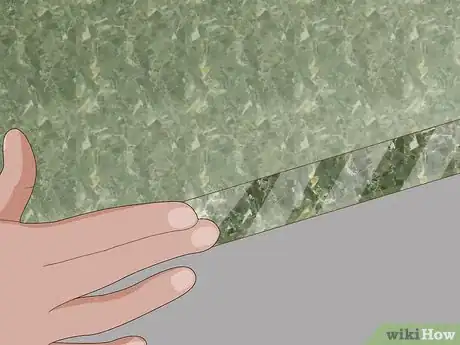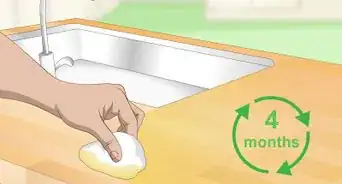This article was co-authored by wikiHow staff writer, Eric McClure. Eric McClure is an editing fellow at wikiHow where he has been editing, researching, and creating content since 2019. A former educator and poet, his work has appeared in Carcinogenic Poetry, Shot Glass Journal, Prairie Margins, and The Rusty Nail. His digital chapbook, The Internet, was also published in TL;DR Magazine. He was the winner of the Paul Carroll award for outstanding achievement in creative writing in 2014, and he was a featured reader at the Poetry Foundation’s Open Door Reading Series in 2015. Eric holds a BA in English from the University of Illinois at Chicago, and an MEd in secondary education from DePaul University.
There are 7 references cited in this article, which can be found at the bottom of the page.
This article has been viewed 67,116 times.
Learn more...
Corian is a hard-surface building material made out of acrylic and aluminum ore. It is commonly used for countertops and is often mistaken for marble or granite.[1] Cutting Corian is quite simple, but be sure to take the proper safety precautions by wearing protective eyewear and a dust mask or respirator. Work in a well-ventilated area, since the dust created when cutting Corian can irritate the lungs and eyes.
Things You Should Know
- Measure the height, length, depth, and width of the installation area. Mark the dimensions on the underside of the Corian slab with a grease marker.
- Line up the circular saw's base plate with the top of the grease marking. Use the lever to set the depth of the blade before locking it in.
- Pull the trigger on the saw and move it forward to start cutting the Corian. Smooth out the cut edges with 100-150 grit sandpaper.
Steps
Measuring and Marking Cuts
-
1Measure the area where you’re installing your Corian. Take measurements for the height, length, depth, and width of your area using a retractable measuring tape. Double-check your measurements before you mark anything on your Corian. Jot down the dimensions on a piece of paper so that you can easily refer to them. You don’t want to waste an entire slab of material because your initial measurement was off!
-
2Steady your Corian upside-down on top of your work surface. You can use two sawhorses, a stable workbench, or a cutting table to cut your Corian. Corian can be rather heavy, so you should use a larger workbench if your slab of Corian is particularly big.
- Use clamps to hold the Corian in place, if necessary.
Advertisement -
3Mark your Corian where you’re going to cut with a grease marker. On the underside of your Corian, use your previous measurements to measure out and mark the dimensions that you need to cut with a grease marker. Use a straight edge and tilt your marker at a 45-degree angle to steady your hand as you draw your lines.
- You want to mark the underside of the Corian so that there are no visible markings left after you’ve installed it.
-
4Attach a triple chip blade and made of tungsten carbide to your saw. You can use any kind of circular saw to cut Corian, but the blade has to be a triple chip blade made out of tungsten carbide. Any other sawblade can damage your Corian or your circular saw. You could also risk losing control of your circular saw, which could be disastrous.
- Your saw’s material and blade type will be printed on the side of the saw blade.
Warning: You cannot use a ripping or combination blade, even if it is triple chip and made of tungsten carbide. It will cut your Corian unevenly and permanently damage it.
-
5Put on your protective eyewear and dust mask or respirator. While the chemical components of Corian are non-toxic, there are health hazards associated with the cutting of Corian. The dust caused by cutting is an irritant and can damage your lungs, throat, and eyes. Wear protective eyewear and a dust mask or respirator before you start cutting.[2]
- Make your cuts in a well-ventilated area, preferably outside.
Cutting with a Circular Saw
-
1Put a straight edge next to the guiding line with clamps for clean cuts. Clamp a leveler 1.5 inches (3.8 cm) away from your grease marking, parallel to the guiding line that you’re going to cut. Place the base plate of your saw against the straight edge where you plan on cutting to ensure that the guiding line on the saw and the grease marking are on top of one another. Make adjustments to the placement of your leveler if you need to move the straight edge.[3]
- A straight edge will support the base plate of your circular saw while you cut
- A leveler is a rectangular tool that contains a measuring side and a sequence of tubes with air bubbles in them. The air bubbles float back and forth depending on how you hold it, and you can tell if you have a level surface if the bubbles float in the middle.
- Keep your leveler on the side opposite of your circular saw’s handle. This will put any excess pressure on the straight edge and keep your blade from sliding away as you cut.
Tip: A leveler has have the added benefit of letting you know whether your work surface is flat or not.
-
2Put your circular saw on top of the grease marking. On the edge of your slab of Corian, use the guiding line on the base plate of your saw to line it up with the grease marking where you want to cut. Set the depth of your blade by using the lever on the side and lifting your saw blade before locking it in.[4]
- Make your blade to extend slightly beyond the bottom of your Corian slab, roughly 1–2 inches (2.5–5.1 cm).[5]
- Put both hands on the upper handles of your circular saw before you start cutting.
-
3Pull the trigger on your saw and begin to cut along your line. Wait for the blade to spin at full speed before you start moving it forward. Push your saw forward slightly and as your blade begins to cut the Corian, stop pushing. The saw will do the work for you and the blades will naturally pull it forward.[6]
- When your cut is complete, wait for your blade to come to a complete stop before moving it.
-
4Release the trigger if you encounter kickback or smoke. The friction between your saw blade and the Corian may create a lot of heat. If your saw blade starts to smoke, you’re moving too quickly. Wait for a few minutes and let your blade cool down before you continue to cut. If your blade jumps as you’re cutting and starts kicking back, release the trigger and wait for a moment before you resume cutting.
Finishing the Edges
-
1Inspect your edges for any pieces you may have missed. Look along every edge where you cut and look for any chunks of Corian that you may have missed with your circular saw. You need the edges of your Corian to be flat when installing it, so if you missed a section, reattach your circular saw and cut again.
-
2Start sanding your edges with 100-150 grit sandpaper. Use medium-grit sandpaper to begin smoothing your edges. Attach your sandpaper to your sander and turn it on. Hold it up to the edge of your Corian and carefully press it into the material so that it rests on top. Slide your sander back and forth along each section of the edges to remove excess bumps and sharp edges.[7]
- You can opt for a sanding belt or a sanding disc. They’ll both work for the job.[8]
- You can sand your edges by hand, but it will take quite a bit of energy and won’t result in a uniform finish.
-
3Move up to a higher grit if you’re having trouble getting a clean finish. If the sides and edges of your Corian are still rough after 2-3 applications of the sandpaper, move up to 320-400 grit. The lighter sandpaper will help wear away the smaller bumps and groves in your Corian.[9]
-
4Inspect your edges by running your hand along them slowly. Without applying any pressure, run your hand along the edges of your Corian. If each side is smooth to the touch, then you’re done sanding and are ready for installation. If they’re still a little bumpy or coarse, continue sanding before testing them again.
Tip: You can round your edges with your sander if you don’t want each corner to be a perfect 90-degree angle. Just make sure that you’ve accounted for this when you measured your Corian.
Things You’ll Need
Measuring Your Cuts
- Retractable measuring tape
- Dust mask or respirator
- Protective eyewear
- Grease marker
Using Your Circular Saw
- Circular saw
- Triple-chip tungsten carbide saw blade
- Stable work surface
- Leveler (optional)
- Clamps
Finishing Your Edges
- Sandpaper
- Sander
References
- ↑ https://www.chicagotribune.com/news/ct-xpm-1996-06-14-9606140296-story.html
- ↑ https://ovsco.com/wp-content/uploads/2015/12/Safety-Working_with_Corian.pdf
- ↑ https://youtu.be/uIt4i8g7ZAc?t=74
- ↑ https://youtu.be/4jpOYxRyTFY?t=59
- ↑ https://youtu.be/4jpOYxRyTFY?t=99
- ↑ https://youtu.be/4jpOYxRyTFY?t=160
- ↑ https://www.thisoldhouse.com/ideas/choosing-and-using-sandpaper
- ↑ https://www.thisoldhouse.com/ideas/choosing-and-using-sandpaper
- ↑ https://www.thisoldhouse.com/ideas/choosing-and-using-sandpaper







































































